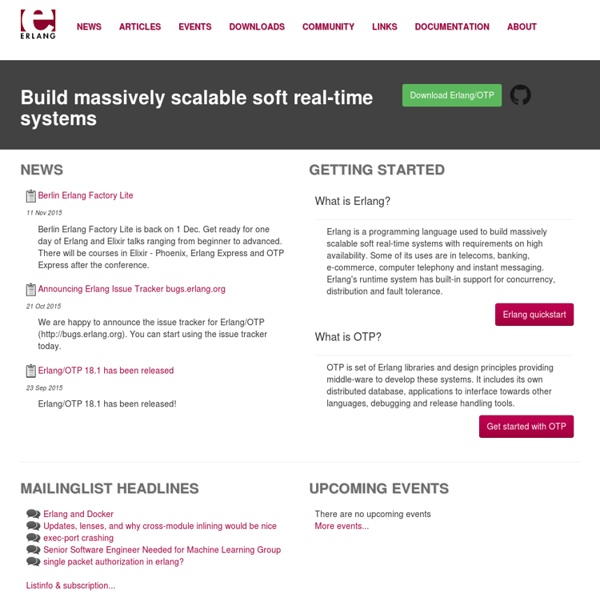



Monads Are Not Metaphors 27 Dec 2010 This article is also available in Japanese. I am about to break a promise. Almost three years ago, I promised myself that I would never write an article about monads. There are too many such articles already; so many, in fact, that people are often confused by the sheer proliferation. Select a Language Help What is repl.it? It is an online environment for interactively exploring programming languages. The name comes from the read-eval-print loop, the interactive toplevel used by languages like Lisp and Python. Unconventional architectures that might scale (I) I’m experimenting with some unconventional architectural ideas (at least from a Java developers view) while designing a new architecture for Dutch broadcaster VPRO. In this series of blogposts I’ll try to explain some of the concepts; please feel free to point out issues/caveats I failed to notice! Some aims of the architecture ReliablePerformant & Scalable (VPRO is running high traffic sites like 3voor12 and cinema.nl)Language agnostic frontend (and preferably backend)Web OrientedMaintainableOffers option to create new concepts and deliver to yet unknown platform with existing content Conceptually I would like to solve this by creating ‘services’ (no, not talking about ‘classical’ SOA here) around specific domains. For example everything about writing articles, like for instance workflow, would be in the ‘articles’ service.
Rich Dougherty's blog: Tail calls, @tailrec and trampolines Recursion is an essential part of functional programming. But if each call allocates a stack frame, then too much recursion will overflow the stack. Most functional programming languages solve this problem by eliminating stack frames through a process called tail-call optimisation. 30 Best JavaScript Tools – 2014 There are number of javascript tools are being released by developers to perform distinctive tasks, but finding a tool which can accomplish multiple tasks is quite a difficult job to do. Therefor sparing your time and efforts, we have compiled a list of javascript tools which are capable of performing number of tasks for you. In this article we have gathered a list of Best JavaScript Tools that might be useful for developers in 2014.
Elasticsearch.org Elasticsearch Document oriented Store complex real world entities in Elasticsearch as structured JSON documents. All fields are indexed by default, and all the indices can be used in a single query, to return results at breath taking speed. Level Programming in Scala This series is intended as a guided tour of some type-level programming I have done in Scala. It generally consists of code and examples with a few lines of explanation. It is usually assumed that the reader understands the features of Scala’s type system. This is not always a good assumption about either the author or the reader of course, so comments and questions are welcome.
40 Useful JavaScript Libraries Popular JavaScript libraries such as jQuery, MooTools, Prototype, Dojo and YUI can be great for accomplishing common JavaScript tasks. These libraries provide many functions, whether the matter is related to events or effects or AJAX. And if one of these libraries can’t do the job, a plug-in probably exists that can. Such flexibility is great but sometimes comes with a penalty (the size of JavaScript files being one of them). Although adopting a well-known JavaScript library is usually a wise decision, you may want to perform a task that can be accomplished by a more lightweight library dedicated exclusively to that task or that is not supported by the more popular JavaScript libraries. You may want to take a look at the following related posts:
Couchbase - Mobile Developers Todo Lite is an example app for collaborative task list management. It illustrates many of the Couchbase Lite features, including document CRUD, binary attachments, view queries, authentication, and sync. Once you have it up and running you can read the source code to see examples of using Couchbase Lite in action. Open the Terminal application. Terminal is usually located in the Applications/Utilities folder. Move to your working directory
Purely functional recursive types in Haskell and Python """This post is simultaneously Python and literate Haskell. There is a certain truth to Greenspun's tenth law of programming. A Python project I was developing at work has slowly mutated into a compiler for a programming language without me planning it that way. Coding your first cross platform app with Intel XDK In the first part of this series we looked at an overview of Intel XDK. In this second part we will look at the frameworks available that help us build an app and start building a simple photo sharing app with the App Framework. The final code for the application we will be working on can be found here on GitHub. Comparing the Frameworks Intel XDK supports several different HTML5 frameworks: App Framework, Bootstrap, TopCoat and JQuery Mobile.
Delightful Coding in Scala - Using Scala Code from Java In this article we present several program samples combining Scala code with Java code. Companion objects A companion module (or companion object) of a Scala class is an object which has the same name as the class and is defined in the same scope and compilation unit. Conversely, the class is called the companion class of the module (see SLS 5.4). // File companion.scalaclass Companion { def hello() { println("Hello (class)") } // [1]}object Companion { def hallo() { println("Hallo (object)") } // [2] def hello() { println("Hello (object)") } // [3]} Calling a Scala method from Java is straightforward (cases [1] and [2]) unless it is defined both in a class and in its companion object (case [3]):
Kanso documentation Developing applications Guides to help you get started building apps with Kanso. Here are some recommended tools and approaches, but since apps just use normal HTML and JavaScript, there are a whole host of frameworks and libraries available to you that may not be listed here.